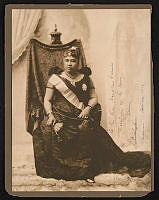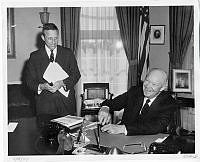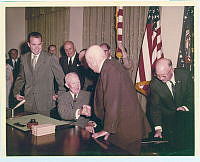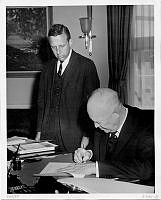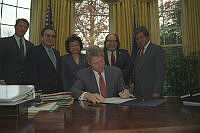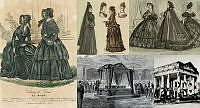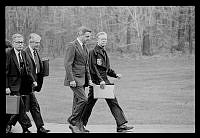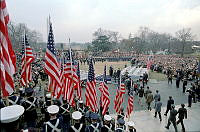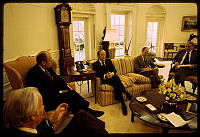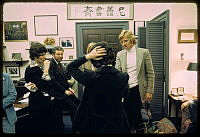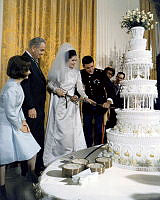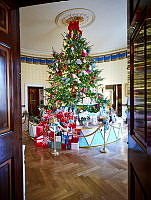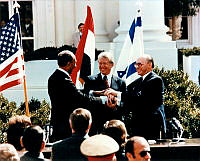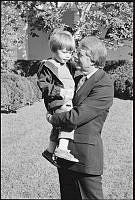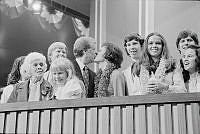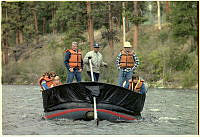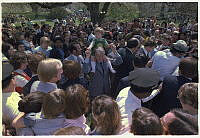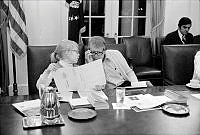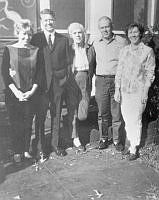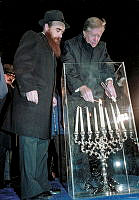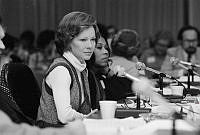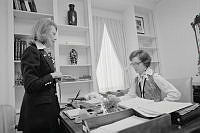Rubenstein Center Scholarship
The Life and Presidency of Grover Cleveland
The White House Christmas Ornament 2007 Historical Essay
ROAD TO THE WHITE HOUSE
One of nine children of a Presbyterian minister and his wife, Stephen Grover Cleveland was born in Caldwell, New Jersey, on March 18,1837, and raised in upstate New York. He grew to an imposing appearance; nearly six feet tall and almost three hundred pounds, he was distinguished by a bulldog set of the jaw, piercing eyes, large mustache, and black business attire. He earned the nickname "Ugly Honest" for his tough look and his integrity. Admitted to the bar in 1859, he held a variety of positions before entering politics. In an era of "robber barons," burgeoning trusts, railroad empires, discontented farmers, labor unrest, and the birth of unions, he was determined to make things better. While rising to a political prominence that would sweep him into the White House, he served as sheriff of Erie County, New York (1871–74); mayor of Buffalo (1881); and governor of the state of New York (1882–85). In 1884 Cleveland became the first Democrat elected to the presidency after the Civil War drawing the support of "Mugwumps" (a combination of Democrats and reform Republicans) unhappy with the record of his Republican opponent James G. Blaine.
The 1884 presidential contest was a no-holds-barred fight. The Democratic Party's strategy was to create an image of the influential James Blaine as a disreputable seller of political favors while stressing Cleveland's appeal as an honest reformer. He had hired a substitute to take his place in the Union Army during the Civil War, a legal and common practice, which nevertheless was often fatal to a Northern politician's career. He was tagged "the hangman of Buffalo" for personally hanging two criminals while sheriff, rather than delegating the job. Cleveland was also accused of consorting with prostitutes and recent scholarship has shed new light on the allegations made by Maria Halpin, who accused Cleveland of assaulting and impregnating her in 1874. He never denied paternity and arranged for Maria to be institutionalized against her will so that he could gain custody of the child, whom he named Oscar Folsom Cleveland. During the 1884 election, Democratic Party strategists insisted that Maria had slept with several men, including Cleveland’s deceased law partner, Oscar Folsom, and that Cleveland claimed the child to protect Folsom’s marriage. However, there is no evidence to suggest Halpin ever had a relationship with Folsom. Nonetheless, the revelation during the campaign inspired a famous ditty: "Ma! Ma! Where's my pa! Gone to the White House, Ha! Ha! Ha!"
CLEVELAND'S FIRST TERM, 1885–89
During his first term, President Cleveland maintained a policy barring special favors to any economic group and repeatedly vetoed private bills and pork-barrel legislation. In 1887 he angered voters by vetoing the Dependent Pension Bill of 1887, which would have granted pensions for disabilities not caused by military service. He also vetoed legislation to appropriate $10,000 for seed distribution to drought-stricken Texas farmers, writing, "Federal aid in such cases encourages the expectation of paternal care on the part of the Government and weakens the sturdiness of our national character . . . " He angered the railroads by forcing them to return 81 million acres of western lands they held by government grant and signing the Interstate Commerce Act, the first federal law regulating the railroads. Calling on Congress to reduce high protective tariffs, he was told that he had given Republicans an issue for the next campaign. He retorted, "What is the use of being elected or reelected unless you stand for something?" Cleveland was defeated in 1888 by Benjamin Harrison a Republican from Indiana.
A PRESIDENTIAL ROMANCE AND WEDDING
The early Cleveland White House was a bachelor's household; the president worked long hours and rarely entertained. Rose Cleveland, the president's sister, acted as first lady, managed the affairs of the residence, and spent much of her time studying. No sooner did the public become accustomed to the image of a lonely White House, than did the picture change. President Cleveland had been secretly courting Frances "Frank" Folsom, the daughter of Oscar Folsom, his late law partner. When Folsom was killed in a carriage accident, Cleveland became the administrator of his estate and the ward of then 12-year old Frances, devoting himself to the welfare of the girl and her mother.
Intimates of the Clevelands and Folsoms knew that the attachment between the president and Frank was more than friendship. A year before he went to the White House, he obtained permission from Mrs. Folsom to correspond with her daughter. A graduate of Wells College at Aurora, New York, Frances was bright, had an animated wit, unaffected nature, and natural beauty that left the president smitten. Their courtship was conducted largely by mail and the president included his proposal of marriage in a letter. On May 28, 1886, after Frances and her mother returned from a nine-month tour of Europe, the formal announcement of the engagement was made; five days later, the 49-year old bachelor married 21-year old Frances Folsom in a small White House ceremony. The public was captivated.
On Wednesday, June 2, 1886, at 6:30 in the evening, cabinet members and their wives, selected government officials and close family friends were ushered into the Blue Room. The state floor was decorated with a profusion of palms, ferns, and flowers from the White House greenhouses. At the east end of the grand Cross Hall, the Marine Band, led by John Philip Sousa, played the Wedding March. Cleveland and his bride, with no attendants, descended the stairs, crossed the hall and stood beneath the flower-laden chandelier in the Blue Room. Presbyterian minister, Reverend Byron Sunderlund performed a specially written rite of marriage. The couple then led their guests through the Green Room into the East Room, where they promenaded in the shimmering light of the gas chandeliers. The new Mrs. Cleveland wore an elegant wedding gown of heavy corded satin draped in frail, pearl white, India silk, edged in real orange blossoms. A pair of silk scarves criss-crossed the front of the dress covering the low Parisian neckline. Her long silk veil was held in place with orange blossoms and seed pearls; attached to the bodice was a 15-foot silk train.
After about a half an hour had passed in promenade, the doors of the Cross Hall were opened and the bride and groom led the guests to the State Dining Room for a seated, candlelit dinner. A three-masted ship made of flowers and christened the Hymen dominated the table. After dinner the bride and groom disappeared to change into street clothes for traveling and left the White House by way of the Blue Room where a coach awaited at the foot of the South Portico stairs. Canvas screens blocked the public's view. Escorted by mounted police, coachman Albert Hawkins drove the carriage through a cheering crowd down Pennsylvania Avenue. The Clevelands traveled by private railroad car to Deer Park Resort in the mountains of western Maryland for their honeymoon.
CHRISTMAS AT RED TOP
On the same day that the president's engagement was announced, he signed the closing papers on an old stone house in northwest Washington. He hired Washington architect William Poindexter to remodel the place into a picturesque modern Queen Anne villa, with porches on two levels, dark green woodwork, and a vast roof of wood shingles stained red. Mrs. Cleveland fondly called the house "Oak View," but it came to be known as "Red Top" by the press. From the vantage point of the many reporters who staked out the house, all that could be seen was the red roof nestled among old growth trees. The Clevelands summered at Red Top and used it year-round for short retreats from the White House as well.
The Clevelands spent their first Christmas together at Red Top with Mrs. Folsom, Frank's mother. The Washington Post reported that the cottage was decorated with English holly and evergreens, "in one of the rooms a pretty Christmas tree." Mrs. Cleveland had been seen buying gifts in the crowded downtown shops; she "gently elbowed her way through, and had a pleasant word for the tired shop-girls." President Cleveland actually worked at the White House on Christmas morning and drove to Red Top with Mrs. Cleveland in the afternoon. They had a quiet dinner with Mrs. Folsom and the president's secretary Colonel Daniel Lamont and his family. The president personally addressed envelopes for each member of the residence staff containing a Christmas gift of cash. Mrs. Cleveland participated in a local club that provided a holiday banquet for the city's poor children. Official holiday entertaining began with the public reception on New Year's Day, which opened the winter social season.
A PREDICTION
Not long after losing the 1888 election to Benjamin Harrison, Cleveland decided to move to New York to enjoy a private life there and to pursue business opportunities in Manhattan. The 23-acre Red Top estate was sold and eventually redeveloped; today it is known as the Cleveland Park neighborhood. On Inauguration day (then March 4), Mrs. Cleveland bid traditional farewells to the household staff distributing to each her autographed portrait with a personal note. A teary eyed Jerry Smith, who started his service at the White House as a stable boy for President Grant, attempted to say goodbye, but Mrs. Cleveland interrupted: "Now, Jerry, I want you to take good care of all the furniture and ornaments in the house and don't let any of them get lost or broken, for I want to find everything just as it is now, when we come back." Surprised, he asked her when she expected to return. "We are coming back just four years from to-day," she smiled. The Clevelands would indeed return to the White House, four years later.
SELECTED BIBLIOGRAPHY:
The water color painting of the White House that appears on the box lid is by Mrs. Cleveland, and is at the Grover Cleveland Birthplace State Historic Site, Caldwell, NJ.
Freidel, Frank and Hugh Sidey. The Presidents of the United States of America. Washington, D.C: White House Historical Association, 2006.
Graff, Henry F. Grover Cleveland. New York: Times Books, 2002.
Lynch, Denis Tilden. Grover Cleveland: A Man Four-Square. New York: Horace Liveright, 1932.
McElroy, Robert. Grover Cleveland: The Man and the Statesman: An Authorized Biography. New York: Harper & Brothers, 1923.
Merrill, Horace Samuel. Bourbon Leader: Grover Cleveland and the Democratic Party. Boston: Little, Brown and Company, 1957.
Miller, Patricia. Bringing Down the Colonel. New York: Farrar, Straus and Giroux, 2018.
Nevins, Allan. Grover Cleveland: A Study in Courage. New York: Dodd, Mead, 1933.
Seale, William. The President's House: A History. Washington, D.C: White House Historical Association, 1986.
Seale, William. The White House: The History of an American Idea. Washington, D.C: White House Historical Association, 2002.
ILLUSTRATIONS:
The watercolor painting of the White House that appears on the box lid is by Mrs. Cleveland, and is in the collection of the Grover Cleveland Birthplace State Historic Site.
The Illustration on the ornament booklet cover is from Frank Leslie's Illustrated Magazine and titled, The Wedding at the White House, June 2, The Mother's Kiss. Mrs. Cleveland is in the foreground with her mother, Emma Cornelia.
HISTORIC SITES:
Grover Cleveland Birthplace State Historic Site, 207 Bloomfield Avenue, Caldwell, N.J.
President Cleveland's burial site is in the Princeton Cemetery, Princeton, N.J.













